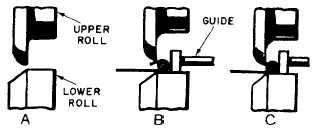BEADING ROLLS.—Beading rolls are used for
turning beads (grooves) on tubing, cans, and buckets.
Beads may also be placed on sheet stock that is to be
welded. There are several different types of beading
rolls. Those shown in figure 13-41 are single bead
rolls. When you are beading, the groove should not
be made too deeply in a single rotation as this tends to
weaken the metal.
TURNING ROLLS.—Turning rolls are used for
turning an edge to receive a stiffening wire. When
you are turning an edge, rest the cylinder to be wired
on the lower wheel and press against the gauge. The
gauge is adjusted according to the size of wire to be
used. With the work set in place, bring the upper roll
down until it grips the metal. Turn the crank slowly
while you are holding the metal so that the metal will
feed into the rolls. Continue to press against the
guide. After the first revolution, gradually raise the
metal until it touches the outer face of the top roll.
Remove the stock by raising the top roll.
WIRING ROLLS.—Wiring rolls are used to
finish the wired edges prepared in the turning rolls.
To use the wiring rolls, you should adjust the top roll
so that it is directly above the point on the lower roll
where the beveled and flat surfaces meet, as shown in
view A of figure 13-42. Adjust the guide to the
position shown in view B, then bring the top roll down
so that it will turn the edge of the metal as shown in
view C.
Remove the stock from the machine by
raising the top roll.
CRIMPING ROLLS.—Crimping rolls are used
to make one end of a pipe smaller than the other so
that two sections may be slipped together, one end
into the other. A bead is placed on a pipe first, and
then it is crimped. The bead forms a shoulder to keep
the pipe from slipping too far into the adjoining
section.
BURRING ROLLS.—Burring is perhaps the
most difficult operation to perform on a rotary
machine. Before you place the work in the machine,
Figure 13-42.—Wiring operation.
make sure the cylinder or circular disc to be burred is
cut or formed as perfectly round as possible. Then
adjust the gauge on the machine so the space between
the inside of the upper roll and the gauge is set to the
width of the burr. Next, place the object between the
rolls and against the gauge. Then you should lower
the upper roll until it scores the material slightly.
Turn the crank slowly to allow the metal to slide
between thumb and fingers. Apply a slight upward
pressure as the metal passes between the rolls. After
the first revolution, lower the top roll and again pass
the metal between the rolls. Repeat this process,
raising the edge slightly with each complete
revolution of the material, until the edge has been
burred to the proper angle.
RIVETING PROCEDURES
You must use your knowledge, ability, and
experience to plan an aircraft structural repair that
involves riveting.
Each rivet must be selected and
driven in a precise manner to meet the riveting
specification. Some of the specifications are rivet
spacing and edge distance, diameter of the rivet hole,
aerodynamic smoothness, and size of the rivet
bucktail. These can be accomplished only through
determination, practice, and accurate manipulation of
all layout and riveting equipment.
Rivet Selection
The following rules should govern your selection
and use of rivets:
1. Replacements must not be made with rivets of
lower strength material unless they are larger than
those removed. For example, a rivet of 2024
aluminum alloy should not be replaced by one made
of 2017 aluminum alloy unless the 2017 rivet is a size
larger. Similarly, when 2117 rivets are used to replace
2017 rivets, the next larger size should be used.
2. When rivet holes become enlarged, deformed,
or otherwise damaged, you should use the next larger
size as replacement.
3. Countersunk-head rivets should be replaced
by rivets of the same type and degree of countersink,
either AN426 or MS20426.
4. All protruding-head rivets should be replaced
with universal-head rivets, either AN470 or
MS20470.
5. Rivets less than three thirty-seconds of an inch
in diameter should not be used for any structural parts,
13-26


